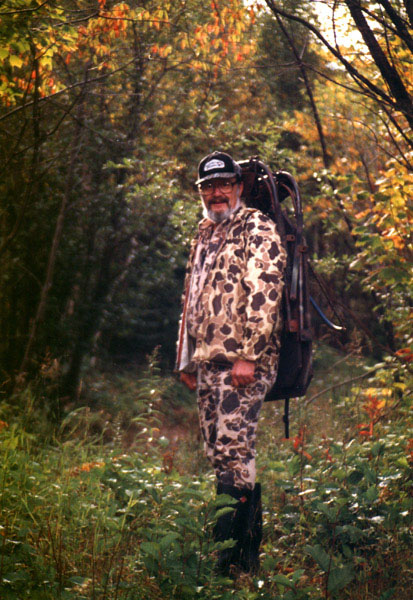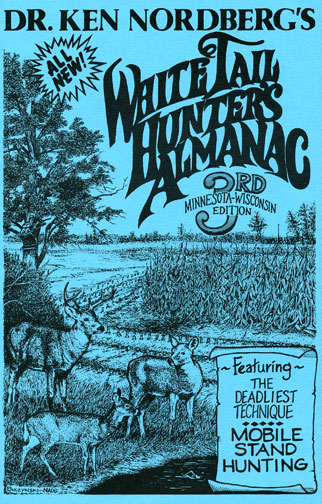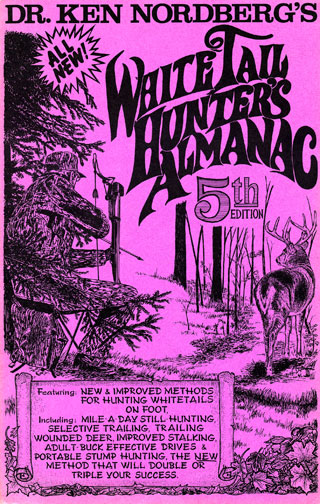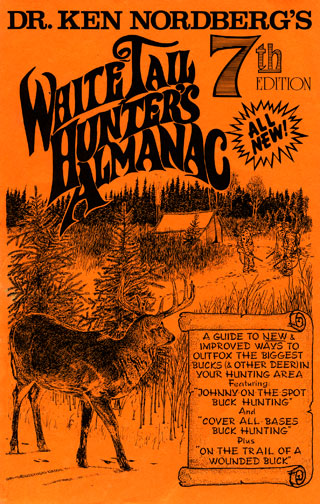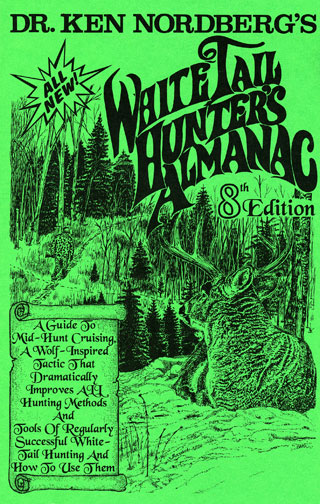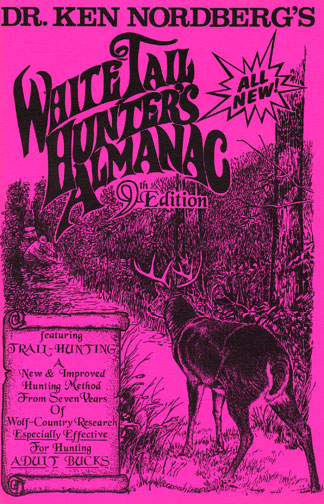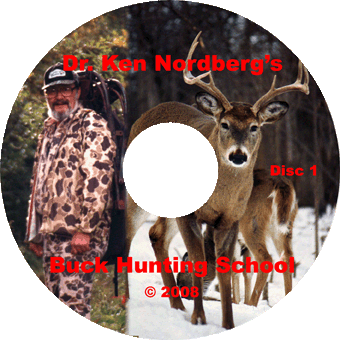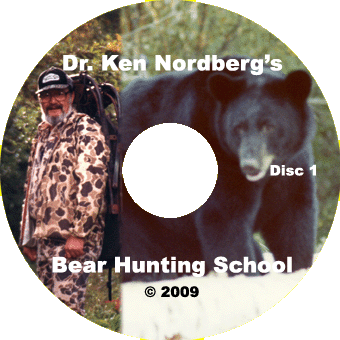Keying On Bedding And Feeding Areas
By Dr. Ken Nordberg
[The following is the another of many older articles that will appear on my website. This is article was first published in Bowhunting World in December of 1993. Please share what you learn from these articles with your whitetail hunting friends.]

To take big bucks while breeding is in progress, hunt feeding and bedding areas of adult does.
Bowhunting as we know today began only two or three decades ago. [Published, December 1993] Elevated stands started it all, enabling even inexperienced hunters to take whitetails within the short, effective range of a bow. Like autumn leaves, an unprecedented, bewildering array of new hunting aids smothered sporting goods shelves during this same period. None captured the imagination of hunters more than so-called buck lures — scents, primarily, but also calls and rattling antlers.
Suddenly, buck hunting was no longer a matter of proper location, only a matter of using the right buck lure. Unfortunately, in the current frenzy of attempting to lure bucks to stand sites, common sense hunting principles are being largely ignored. That's wrong. Whether using a buck lure or not, proper stand location remains an essential element of hunting success. Bucks cannot be lured to stand sites where there are bucks to lure, and buck lures cannot make up for a lack of the ability to select proper stand sites.
There are dozens of sites within home or breeding ranges of adult bucks that are likely to be productive at one time or another, but the best of them, day in and day out, September through December, are feeding and bedding areas, off-trail sites. What about deer trails? How much of a day will a whitetail spend on any section of well-trodden deer trail watched by a hunter in a tree stand? If used at all, generally having at least a dozen trails to use when heading toward any one destination, a whitetail will pass within seconds. It seems illogical to me that hunters spend so much time at sites where whitetails spend less than 1 percent of their day. From dark to dark, whitetails spend four to six hours in feeding areas and four to six hours in bedding areas. By keying on feeding and bedding areas where whitetails spend more than 90 percent of each day, the hunter cannot help but see more deer and have more opportunities to take them. Throughout fall and winter, except while winds are strong or precipitation is moderate-to-heavy, regardless of activities related to breeding, antlered quarries are found in feeding areas twice daily and bedding areas midday. Like no other sites, bucks return to feeding areas and bedding areas over and over again on their own volition.

While whitetails are eating grasses, usually the case when scouting early, evidences of feeding tend to be difficult identify.
To the untrained eye, whitetail feeding and bedding areas are not as easily identified as deer trails, ground scrapes, and antler rubs — obvious deer signs that draw the majority of today's hunters. To find them, the hunter must scout off-trail, something a lot of hunters rarely do.
Deer signs that characterize feeding areas are as follows: 1) lots of off-trail deer tracks, fresh and old, 2) trails of individual deer moving slowly in random directions, 3) lots of off-trail droppings, fresh and old, and 4) evidence of feeding, which may be subtle or obvious.

Current browse areas are loaded with woody plants with white, nipped off stems. When identifying a feeding area, the signs of feeding do not need to be fresh. For example, while spring scouting, this old evidence of feeding on red osier from the prior fall and/or winter is still obvious.
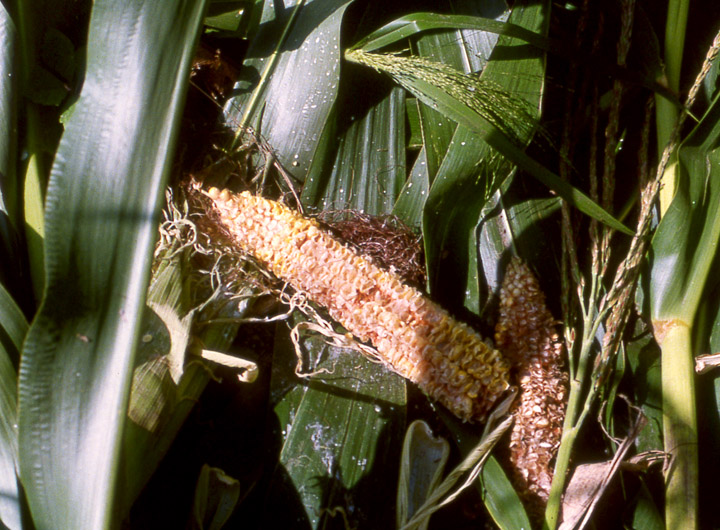
Where whitetails are feeding on corn, evidences of feeding will be obvious.
Where deer are feeding on grasses, the first three signs listed may be the only identifying signs of a feeding area. While leaves are still green, nipped-off stems of saplings and certain shrubs are characteristic where whitetails are feeding in clearcuts. Where whitetails are feeding on corn or soybeans, signs are obvious: cornstalks damaged, cobs stripped bare of corn and main stems of the bean plants nibbled off. An abundance of crushed shells reveal where whitetails are feeding on acorns. After greens are no longer available, signs of feeding or browse areas become very obvious: white tips of nibbled-off stems of woody saplings and shrubs everywhere. Though not quite as obvious when scouting before November, browse areas are distinguished by countless darkened (brown, grey, or black) tips of woody stems where whitetails fed during the previous winter. Fawn beds, 30-36 inches long, are not uncommon in feeding areas; fawns sometime bed while their mothers feed.
Deer signs identifying bedding areas are as follows: 1) beds, often difficult to discern in buck bedding areas, 2) lots of off-trail deer tracks, fresh and old, 3) lots of off-trail droppings, fresh and old, and 4) in the case of older bucks, 6-30 antler rubs within 1-10 acre area, fresh or old. Beds of adult does and their young are generally easy to spot and identify. They are commonly found in deep grasses, spread out over an area 10-40 acres in size. In fall they range in length from 30 inches (fawn) to 42 inches (northern adult doe or yearling buck). Deep grasses are uncommon in the dense, woody bedding favored by adult bucks, making their beds less visible. Where visible, beds of northern adult bucks (2-1/2 to 6-1/2 years of age) measure 45-56 inches in length.
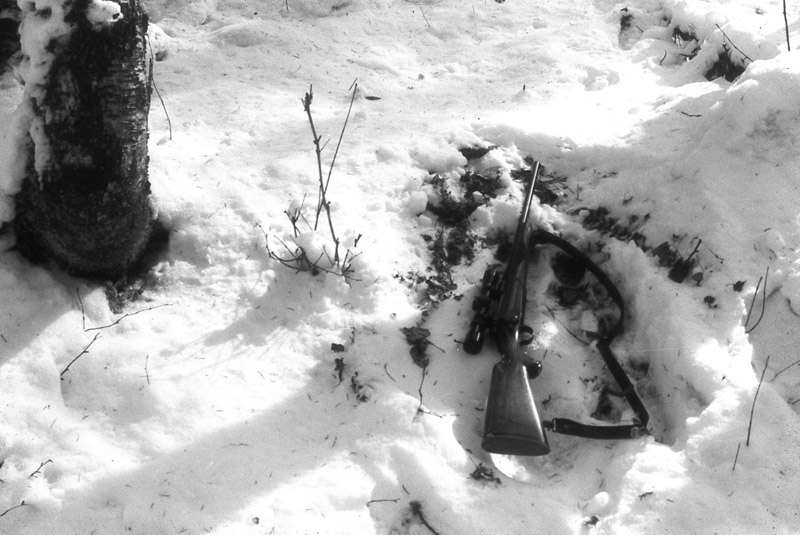
[Doc's notorious rifle, "Big Boomer" is laying in a bed freshly made by his quarry, a very large whitetail buck. Every hunter in the Nordberg gang has learned to instantly recognize the distinct sound of Big Boomer — its about 50% louder and longer sounding than other 7mm mags. Of course, we normally only hear a single shot on opening morning.]
Classes of deer that use specific feeding and bedding areas can be accurately identified by measured tracks and droppings. Fall tracks of northern adult does and young (fawns and yearlings) are 3 to 4-1/2 inches in length (tip to dewclaw), average droppings 1/4 to 1/2 inches in length (not including the nubbins at ends). Tracks of northern adult bucks are 5-6 inches in length (3-1/2 to 4 inches for hoof length only); average droppings (often clumped) 5/8 to 1-1/4 inches in length. Some feeding areas are regularly visited by all classes of deer and will thus be characterized by all sizes of tracks and droppings.
Because of the lengthy periods whitetails are present in feeding and bedding areas, they must be hunted very cautiously, the hunter never moving too near and always remaining downwind, silent and well-hidden. The hunter must carefully plan all approaches and departures, ever mindful the quarry is likely to be very near. Because of changing wind directions demanding the ability to change stand sites frequently, silent ground-level stands, making use of natural, unaltered cover, are preferred over noisy-to-move elevated stands. Elevated stands also usually require considerable altering of stand sites. Typical alterations made by tree stand hunters are readily spotted and avoided by the majority of today's adult bucks. [Keep in mind, this article was published in 1993. At present, most states have laws forbidding making shooting lanes, and the other types of, "alterations" Doc is referring to here.]
Wherever hunted by bowhunters only, whitetails are unlikely to materially alter habits and merely maintain safe distances about identified stand sites. Whereas buck or doe bedding areas avoided by hunters are unlikely to change in location from September through December, natural changes occur in feeding area locations and in movements to and from them. Until the hunter has succeeded in taking a buck, he or she must therefore be prepared to follow quarries to a number of different feeding areas. The feeding areas where adult bucks will be found throughout fall and early winter are primarily influenced by breeding-related activities.

Buck feeding/sparring areas are characterized by signs of battling: patches of torn up turf and soil. [And in this case, snow.]
From velvet-shedding, around September 1st until two to three weeks before breeding begins, most antlered bucks of a 1-2 square-mile area will regularly feed together, sparring and battling late in feeding cycles to determine which of them is most dominant and will thus succeed in establishing an exclusive breeding range. Such feeding areas are clearly marked by large patches of turf or soil torn up by straining hooves, signs of battling bucks. Though adult bucks travel widely though their 300-1,000-acre ranges during this period, they regularly return to their accustomed bedding areas between feeding cycles. To take a buck during this period, hunt buck feeding/sparring areas and/or buck bedding areas.
Early during the two to three weeks before breeding begins dominant bucks run off lesser bucks and begin patrolling their newly established breeding ranges, primarily during periods whitetails normally feed. Feeding fitfully while on the move, they paw out and maintain 30-70 lesser-buck-repelling ground scrapes along major trails used by adult does and their young. Chief among stops along the way are areas where does and young are currently feeding and their own bedding areas. It is during this period that dominant bucks made restless by welling testosterone (male sex hormone) make numerous antler rubs in their bedding areas [Buck Bedrooms. Doc has a good video example of a Buck Bedroom is his Buck Hunting School DVDs.]. During this two-to-three week phase, hunt dominant buck scrape trails [Rut Routes.], off-range scrape trails of lesser bucks, doe family feeding areas, dominant buck bedding areas, and/or temporary off-range areas of displaced lesser bucks.
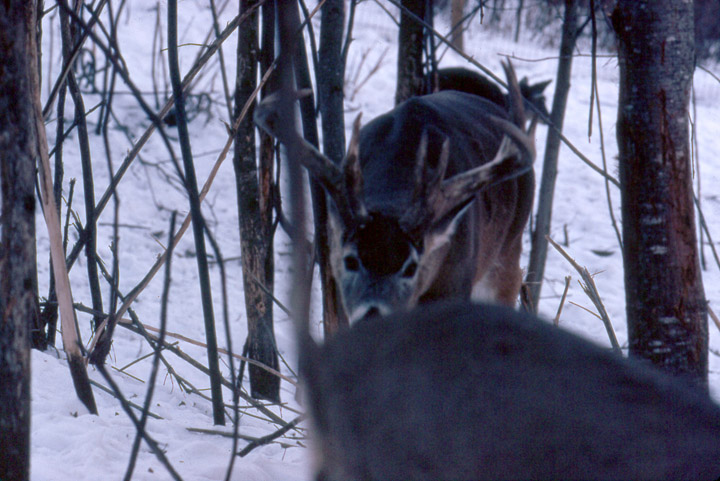
A large whitetail buck closely following a doe in estrus.
When the one-to-two-week primary breeding phase of the rut begins, key on feeding and bedding areas of adult does only. Dominant bucks will not return to their bedding areas, and they will not regularly renew ground scrapes (if at all) during this entire period. They will spend almost all of their time with does in estrus, trailing them as they move to feeding and bedding areas during hours appropriate to current weather and hunting pressure, often shadowed by one or more courageous lesser bucks. Be on the lookout for fresh signs of bucks under the influence of doe-in-estrus pheromone: hooves dragging from track to track (readily seen in snow) or torn up turf where a battle has recently taken place. Upon discovering such a sign, quickly key on the nearest adult doe feeding or bedding area. You must be quick because the doe will only be in estrus 24-26 hours. Expect the doe and buck to move considerably throughout the doe's bedding area midday. This where most of the breeding takes place. Between the four to six times the doe will accept breeding, she will wander [or even run around] to avoid it.
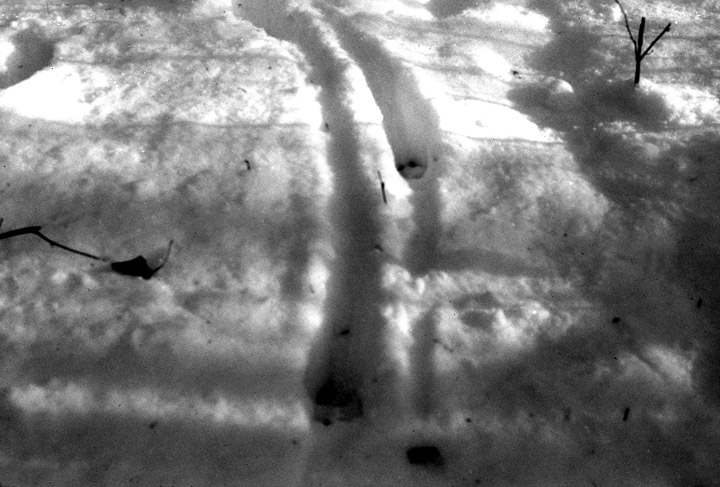
Classic! One of the most exciting types of sign you can discover! The classic "Railroad Tracks" of a big whitetail buck under the influence of a doe's estrus pheromone. (Almost certainly moving upwind.)
After the primary breeding phase of the rut comes to an end, dominant bucks head to their regular bedding areas for seclusion and much-needed rest. Lesser bucks return to their former home ranges, resuming normal habits and behavior. During the first week or so, dominant bucks will feed close to their bedding areas, commonly in the wake of the nearest adult do and young. During this period, hunt feeding areas of does nearest the buck bedding areas and/or buck bedding areas.
Does not bred in November will experience estrus again 28 days later and 28 days after that if still not bred. After the primary breeding phase of the rut is over, dominant bucks are unlikely to attempt to maintain exclusive breeding ranges. In fact, they'll commonly be accompanied by one or more lesser bucks except while under the spell of a late-breeding doe emitting pheromone. They will occasionally make quick circuits of previously-established scrape routes, rarely stopping to renew scrapes, however. Until supplemental breeding begins, continue keying on feeding areas of adult does nearest the buck bedding areas.
Twenty-eight days after the beginning of the rut's primary breeding phase, again keep an eye peeled for signs of bucks under the influence of doe-in-estrus pheromone. Respond quickly, hunting the downwind perimeter of the nearest currently-used adult doe feeding area early and late in the day and the downwind perimeter of the nearest adult doe bedding area midday.
The ability to hunt feeding and bedding areas most effectively is dependent on four skills: 1) recognizing and properly interpreting deer signs, 2) great mobility — making use of an unlimited number of downwind stand sites, whatever the wind direction, 3) silence — being able to move to and set up new stand sites without alerting or alarming nearby whitetails, and 4) quick responsiveness — being Johnny- or Joannie-on-the-spot when and where promising deer signs are discovered. Nothing allows the hunter to exercise such skills better than a portable stool, a ground level portable stand.
If the thought of hunting at ground level makes you feel doubtful or insecure, keep in mind Native Americans hunted whitetails very successfully with bows and arrows at ground level for 10,000 years or more. Moreover, like it or not, the effectiveness of elevated stands and buck lures are waning. Eventually, you may be forced to throw in the towel and hunt at ground level. Don't despair. Once you make up your mind to gain the necessary skills, you'll discover a whole new world of whitetail hunting, one much better than anything you have ever experienced before.
Meanwhile, spend most of your time hunting where deer spend most of their time — at feeding and bedding areas. You'll be glad you did.
Good Luck Hunting,
Doc
[Editor's note: It amazes me how Doc's 1993 writing makes as much sense today as it did over 21 years ago. One hundred years from now, his hunting knowledge will still make sense.
I have listened to him give this advice for over 40 years. So, personally, after transcribing this article, the tips that I would emphasize are:
- Feeding will switch from grasses to browse — so when scouting — do not worry so much about where the deer ARE feeding but where they WILL be feeding. Be sure to designate traditional doe browse feeding areas on your map.
- There IS a great time to hunt a dominant buck — it is the short period just prior to when the does go into estrus — when the dominant buck is establishing his breeding range. A dominant buck is most predictable and and thus perhaps most vulnerable when he is cruising his Rut Route: travelling on major doe trails, making his antler rubs, making and refreshing his ground scrapes. In most northern states — except in unusually warm years — this 2-3 week period is almost always prior to firearm season, during the bow season. So — many firearm hunters make the mistake of hunting: major doe trails, ground scrapes, and antler rubs right at the point the dominant buck stops frequenting them — advantage bowhunters.
- In order to be able to approach silently from crosswind or downwind, you need to know multiple routes to approach the bedding and feeding areas.
- Don't hunt predictably from one stand site (ground or elevated). Deer do not need to see or hear you to know where you are. To verify that you are at your regular stand site they can simply just sniff your trail scent from a safe downwind location. Strive to have a new stand site location (ground and/or elevated) for each half day of hunting or they will quickly have you pegged.]
